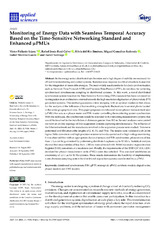Mostrar el registro sencillo del ítem
Monitoring of Energy Data with Seamless Temporal Accuracy Based on the Time-Sensitive Networking Standard and Enhanced μPMUs
| dc.contributor.author | Pallarés López, Víctor | |
| dc.contributor.author | Real Calvo, Rafael Jesús | |
| dc.contributor.author | Río Jiménez, Silvia del | |
| dc.contributor.author | González Redondo, Miguel Jesús | |
| dc.contributor.author | Moreno-García, Isabel | |
| dc.contributor.author | Santiago, Isabel | |
| dc.date.accessioned | 2021-10-01T12:19:08Z | |
| dc.date.available | 2021-10-01T12:19:08Z | |
| dc.date.issued | 2021 | |
| dc.identifier.uri | http://hdl.handle.net/10396/21772 | |
| dc.description.abstract | In the energy sector, distributed synchronism and a high degree of stability are necessary for all real-time monitoring and control systems. Instantaneous response to critical situations is essential for the integration of renewable energies. The most widely used standards for clock synchronisation, such as Network Time Protocol (NTP) and Precision Time Protocol (PTP), do not allow for achieving synchronised simultaneous sampling in distributed systems. In this work, a novel distributed synchronism system based on the Time-Sensitive Networking (TSN) standard has been validated for its integration in an architecture oriented towards the high-resolution digitisation of photovoltaic (PV) generation systems. This method guarantees a time stamping with an optimal resolution that allows for the analysis of the influence of fast-evolving atmospheric fluctuations in several plants located in the same geographical area. This paper proposes an enhanced micro-phasor measurement unit (μPMU) that acts as a phasor meter and TSN master controlling the monitoring system synchronism. With this technique, the synchronism would be extended to the remaining measurement systems that would be involved in the installation at distances greater than 100 m. Several analyses were carried out with an on-line topology of four acquisition systems capturing simultaneously. The influence of the Ethernet network and the transducers involved in the acquisition process were studied. Tests were performed with Ethernet cable lengths of 2, 10, 50, and 75 m. The results were validated with 24-bit Sigma-Delta converters and high-precision resistor networks specialised in high-voltage monitoring. It was observed that with an appropriate choice of sensors and TSN synchronism, phase errors of less than ±1μs can be guaranteed by performing distributed captures up to 50 kS/s. Statistical analysis showed that uncertainties of less than ±100 ns were achieved with 16-bit Successive Approximation Register (SAR) converters at a moderate cost. Finally, the requirements of the IEEE C37.118.1-2011 standard for phasor measurement units (PMU) were also satisfied. This standard establishes an uncertainty of ±3.1 μs for 50 Hz systems. These results demonstrate the feasibility of implementing a simultaneous sampling system for distributed acquisition systems coordinated by a μPMU. | es_ES |
| dc.format.mimetype | application/pdf | es_ES |
| dc.language.iso | eng | es_ES |
| dc.publisher | MDPI | es_ES |
| dc.rights | https://creativecommons.org/licenses/by/4.0/ | es_ES |
| dc.source | Applied Sciences 11(19), 9126 (2021) | es_ES |
| dc.subject | Distributed synchronism | es_ES |
| dc.subject | TSN | es_ES |
| dc.subject | gPTP | es_ES |
| dc.subject | Microgrid | es_ES |
| dc.subject | μPMU | es_ES |
| dc.subject | Synthetic models | es_ES |
| dc.subject | Digital twins | es_ES |
| dc.subject | Phasor models and EMT models | es_ES |
| dc.title | Monitoring of Energy Data with Seamless Temporal Accuracy Based on the Time-Sensitive Networking Standard and Enhanced μPMUs | es_ES |
| dc.type | info:eu-repo/semantics/article | es_ES |
| dc.relation.publisherversion | https://doi.org/10.3390/app11199126 | es_ES |
| dc.relation.projectID | Gobierno de España. PID2019-108953RAC22 | es_ES |
| dc.relation.projectID | Gobierno de España. PID2019-108953RB-C21 | es_ES |
| dc.rights.accessRights | info:eu-repo/semantics/openAccess | es_ES |

